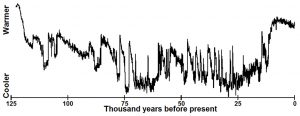New Research Shows Volcanoes Cause Both Sudden Global Warming and Slow Global Cooling
October 11th, 2016
Dr. Peter L. Ward, U.S. Geological Survey retired, shares new research about the role of volcanoes in global warming and global cooling for Earth Science Week 2016.

The footprints of climate change in ice cores show sudden warming followed by much slower cooling in erratic sequences, averaging 5000 years, that are not cyclic.
According to new research by Dr Peter L Ward, the distinctive footprints of climate change throughout earth’s history show sudden warming within years and slow cooling within thousands of years. Ice cores, where annual layers can often be observed, show clear evidence that major global warming usually begins suddenly within years while major global cooling typically occurs slowly over thousands of years.
“Sudden warming followed by slow cooling happened at least 25 times during the last 100,000 years of the last ice age,” explains Dr. Peter L. Ward who studied volcanoes for 27 years with the U.S. Geological Survey. “These sequences do not occur in regular cycles, however. They occur randomly—sporadically.”
Ward recently reported these observations at the annual meeting of the Geological Society of America and in a seminar at the Geological Society of London. Videos of his talks are available at WhyClimateChanges.com/videos/. He also explains the science behind these observations in a new paper published in Current Physical Chemistry.
Around 12,000 years ago, massive basaltic volcanism began in Iceland and continued for more than 2000 years, warming the ocean out of the last ice age. The ocean contains the vast majority of the heat in the climate system and is the thermostat that regulates air temperatures.
Smaller warmings during the Roman Warm Period and the Medieval Warm Period were also initiated by effusive volcanism where basaltic lavas flow out over hundreds of square miles of land.
“2016,” Ward explains, “appears to be the hottest year on record because the volcano Bárðarbunga in central Iceland extruded basaltic lava over an area of 33 square miles in just six months starting in August 2014.” Bárðarbunga was the largest effusive eruption since 1783 when the Icelandic volcano Laki extruded basaltic lava over an area of 218 square miles.
Nearly 252 million years ago, basaltic lavas in Siberia poured out for tens of thousands of years over an area of 2.7 million square miles, equivalent to all of the contiguous United States minus Texas and Montana. Imagine lava flows extending from Miami to Los Angeles to Seattle to New York.
The Siberian basalts were contemporaneous with major warming, major acidification of the oceans, and the largest mass extinction in Earth history. Nearly 96% of all marine species and 70% of all terrestrial vertebrates went extinct.
Throughout Earth history, the geologic record is punctuated by such large basalt flows occurring on average every 22 million years.
A fundamentally different kind of volcanism causes global cooling. Large, explosive, volcanic eruptions eject water vapor and sulfur dioxide into the lower stratosphere where they form an aerosol, a mist, that spreads around the world within months, that lasts for a few years, and whose droplet sizes grow large enough to reflect and scatter sunlight, cooling earth nearly one degree Fahrenheit.
The largest of this kind of volcanism since 1912 occurred in 1991 at Mt. Pinatubo in the Philippines. Such cooling has been observed after most major explosive eruptions in written history.
Computer modelling shows that when the whole ocean surface is cooled for three years, cooling persists at depth for at least a century. Several such large eruptions per century happening for thousands of years, is observed to cool the ocean down into ice-age conditions.
Throughout geologic time, Earth’s climate appears to warm suddenly whenever large flows of basaltic lava appear and to cool slowly whenever large explosive volcanic eruptions occur regularly for thousands of years. Chlorine and bromine gases emitted by volcanoes are observed to deplete the ozone layer, allowing more ultraviolet solar radiation to reach Earth, causing rapid warming. The aerosols formed by explosive volcanoes, however, lead to net global cooling. Effusive, basaltic volcanoes that do not form significant aerosols, lead to net global warming.
Ward’s analysis and theory are explained in detail on his website WhyClimateChanges.com and in his new book “What Really Causes Global Warming? Greenhouse Gases or Ozone Depletion?”
These observations are presented as part of Earth Science Week, October 9 through 15, organized by the American Geosciences Institute to help the public gain a better understanding and appreciation for the Earth Sciences.
About Peter Ward:
Dr. Ward worked 27 years with the United States Geological Survey as research geophysicist, branch chief, and program manager. He helped develop and manage a major national research program, chaired a committee at the White House, testified before Congress, worked on a committee for Vice President Gore, published more than 50 scientific papers, and won two national awards for explaining science to the general public. He retired in 1998, working intensely for the past decade trying to resolve several enigmatic observations related to climate change.
Previous Post: Supreme Court’s Stay of EPA Carbon Rules Gives Time to Get the Climate Science Right